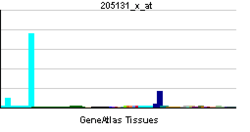CLEC11A
| CLEC11A | |||||||||||||||||
|---|---|---|---|---|---|---|---|---|---|---|---|---|---|---|---|---|---|
| Identifiers | |||||||||||||||||
| Aliases | CLEC11A, CLECSF3, LSLCL, P47, SCGF, C-type lectin domain family 11 member A | ||||||||||||||||
| External IDs | MGI: 1298219 HomoloGene: 2236 GeneCards: CLEC11A | ||||||||||||||||
| |||||||||||||||||
| RNA expression pattern | |||||||||||||||||
   | |||||||||||||||||
| More reference expression data | |||||||||||||||||
| Orthologs | |||||||||||||||||
| Species | Human | Mouse | |||||||||||||||
| Entrez | |||||||||||||||||
| Ensembl | |||||||||||||||||
| UniProt | |||||||||||||||||
| RefSeq (mRNA) | |||||||||||||||||
| RefSeq (protein) | |||||||||||||||||
| Location (UCSC) | Chr 19: 50.72 – 50.73 Mb | Chr 7: 44.3 – 44.31 Mb | |||||||||||||||
| PubMed search | [1] | [2] | |||||||||||||||
| Wikidata | |||||||||||||||||
| View/Edit Human | View/Edit Mouse |
C-type lectin domain family 11 member A is a protein that in humans is encoded by the CLEC11A gene.[3][4][5]
This gene encodes a member of the C-type lectin superfamily. The encoded protein is a secreted sulfated glycoprotein and functions as a growth factor for primitive hematopoietic progenitor cells. An alternative splice variant has been described but its biological nature has not been determined.[5]
References
- ↑ "Human PubMed Reference:".
- ↑ "Mouse PubMed Reference:".
- ↑ Hiraoka A, Sugimura A, Seki T, Nagasawa T, Ohta N, Shimonishi M, Hagiya M, Shimizu S (Aug 1997). "Cloning, expression, and characterization of a cDNA encoding a novel human growth factor for primitive hematopoietic progenitor cells". Proc Natl Acad Sci U S A. 94 (14): 7577–82. doi:10.1073/pnas.94.14.7577. PMC 23864
 . PMID 9207134.
. PMID 9207134. - ↑ Bannwarth S, Giordanengo V, Lesimple J, Lefebvre JC (Mar 1998). "Molecular cloning of a new secreted sulfated mucin-like protein with a C-type lectin domain that is expressed in lymphoblastic cells". J Biol Chem. 273 (4): 1911–6. doi:10.1074/jbc.273.4.1911. PMID 9442024.
- 1 2 "Entrez Gene: CLEC11A C-type lectin domain family 11, member A".
Further reading
- Hiraoka A, Ohkubo T, Fukuda M (1987). "Production of human hematopoietic survival and growth factor by a myeloid leukemia cell line (KPB-M15) and placenta as detected by a monoclonal antibody.". Cancer Res. 47 (19): 5025–30. PMID 3304620.
- Mio H, Kagami N, Yokokawa S, et al. (1998). "Isolation and characterization of a cDNA for human mouse, and rat full-length stem cell growth factor, a new member of C-type lectin superfamily.". Biochem. Biophys. Res. Commun. 249 (1): 124–30. doi:10.1006/bbrc.1998.9073. PMID 9705843.
- Bannwarth S, Giordanengo V, Grosgeorge J, et al. (1999). "Cloning, mapping, and genomic organization of the LSLCL gene, encoding a new lymphocytic secreted mucin-like protein with a C-type lectin domain: A new model of exon shuffling.". Genomics. 57 (2): 316–7. doi:10.1006/geno.1999.5762. PMID 10198175.
- Gehling UM, Ergün S, Schumacher U, et al. (2000). "In vitro differentiation of endothelial cells from AC133-positive progenitor cells.". Blood. 95 (10): 3106–12. PMID 10807776.
- Perrin C, Bayle J, Bannwarth S, et al. (2002). "Expression of LSLCL, a new C-type lectin, is closely restricted, in bone marrow, to immature neutrophils.". C. R. Acad. Sci. III, Sci. Vie. 324 (12): 1125–32. doi:10.1016/s0764-4469(01)01392-0. PMID 11803813.
- Hiraoka A, Yano Ki K, Kagami N, et al. (2002). "Stem cell growth factor: in situ hybridization analysis on the gene expression, molecular characterization and in vitro proliferative activity of a recombinant preparation on primitive hematopoietic progenitor cells.". Hematol. J. 2 (5): 307–15. doi:10.1038/sj/thj/6200118. PMID 11920266.
- Strausberg RL, Feingold EA, Grouse LH, et al. (2003). "Generation and initial analysis of more than 15,000 full-length human and mouse cDNA sequences.". Proc. Natl. Acad. Sci. U.S.A. 99 (26): 16899–903. doi:10.1073/pnas.242603899. PMC 139241
 . PMID 12477932.
. PMID 12477932. - Ito C, Sato H, Ando K, et al. (2004). "Serum stem cell growth factor for monitoring hematopoietic recovery following stem cell transplantation.". Bone Marrow Transplant. 32 (4): 391–8. doi:10.1038/sj.bmt.1704152. PMID 12900775.
- Lee E, Min HK, Oskeritzian CA, et al. (2004). "Recombinant human (rh) stem cell factor and rhIL-4 stimulate differentiation and proliferation of CD3+ cells from umbilical cord blood and CD3+ cells enhance FcepsilonR1 expression on fetal liver-derived mast cells in the presence of rhIL-4.". Cell. Immunol. 226 (1): 30–6. doi:10.1016/j.cellimm.2003.11.001. PMID 14746805.
- Hollenbeck ST, Sakakibara K, Faries PL, et al. (2004). "Stem cell factor and c-kit are expressed by and may affect vascular SMCs through an autocrine pathway.". J. Surg. Res. 120 (2): 288–94. doi:10.1016/j.jss.2004.01.005. PMID 15234225.
- Gerhard DS, Wagner L, Feingold EA, et al. (2004). "The status, quality, and expansion of the NIH full-length cDNA project: the Mammalian Gene Collection (MGC).". Genome Res. 14 (10B): 2121–7. doi:10.1101/gr.2596504. PMC 528928
 . PMID 15489334.
. PMID 15489334.
This article is issued from Wikipedia - version of the 6/6/2016. The text is available under the Creative Commons Attribution/Share Alike but additional terms may apply for the media files.